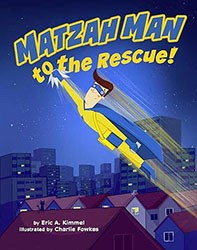Eric Kimmel and Feronia Parker-Thomas’s new Hanukkah picture book begins like a fairy tale: once upon a time, there were three latkes. Children will recognize a familiar fable with characters who have some qualities in common but are also different. While almost everyone may like potato pancakes, especially during Hanukkah, reasonable people may disagree about which kind are best. In this charming story, latkes made from red, yellow, and gold potatoes argue over which one is best. Even the different kinds of fat used for frying promote themselves as most ideal. Is there really a definitive answer to this age-old question? Curious readers will want to know, but they will also learn a lesson about pointless boasting.
Kimmel’s narration is low-key; the latkes’ self-important boasts are a bit silly, but their competition is not actually hostile. Children will obviously recognize the characters’ interactions as typical of school and playtime, where everyone wants to stand out by being special in some way. They begin with unsubstantiated claims of greatness but move on to offering evidence to support their claims. Vegetable oil adds beautiful color, chicken schmaltz is tasty, and peanut oil is the healthiest. (No doubt, adults reading with their children will have strong opinions about some of these assertions). Just as children often need an adult to mediate their conflicts, the latkes call in their own authority, a hungry and clever cat. Kimmel’s ending recalls folklore classics where words and actions have consequences, although he offsets the message with humor. After all, everyone knows that the fate of a latke is to be eaten and enjoyed.
The simplicity of the pictures adds to the sense that this holiday story is meant as a fantasy. There are relatively few detailed elements on each page, focusing attention on the latkes, the cat, and the book’s overall idea. The latkes are individualized by their accessories: a baseball cap, a fedora, and a proudly worn gold medal, but their stick-figure arms and legs remind readers that they are cartoon-like. The red potato pushes a jar of applesauce toward the cat, while the foolish yellow latke fried in schmaltz is glad to dive into a bowl of sour cream. (Kosher dietary laws do not apply here.) The cat’s blue neckerchief gives him a human touch, as does the fact that he can sit in a chair and place his paws on the table. His facial expressions show that he is pleased to have outwitted some not-very-clever creatures, and gotten a delicious Hanukkah meal at the same time.
There are many customs to enjoy during Hanukkah; eating latkes is definitely high on the list for many children, as well as adults. Eric Kimmel reminds them that there does not need to be a winner in the delicious ways to prepare this treat.
This highly recommended book includes a recipe for latkes.
Emily Schneider writes about literature, feminism, and culture for Tablet, The Forward, The Horn Book, and other publications, and writes about children’s books on her blog. She has a Ph.D. in Romance Languages and Literatures.





